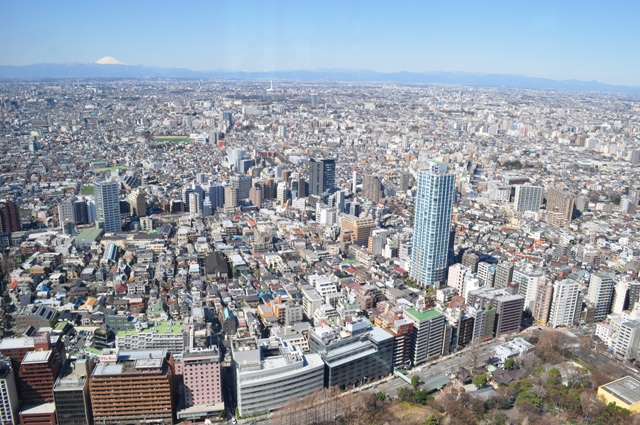
“Travel makes one modest. You see what a tiny place you occupy in the world.” – Gustav Flaubert
Move over New York. Good bye London. Tokyo has taken your place in my heart.
And all it took were 5 days.
It was never supposed to be this way, after all Japan was never on my bucket list. A friend’s wedding brought me to Japan. When you travel without expectations though, the one thing you can expect…are surprises.
I fell fast and I fell hard. My instant love affair began as soon as I stepped off the airport shuttle and into the neon lights of Shinjuku. It happened instantaneously – a connection I can’t explain. That’s the power of travel. It can knock you off your feet. It can transform you. It teaches you.
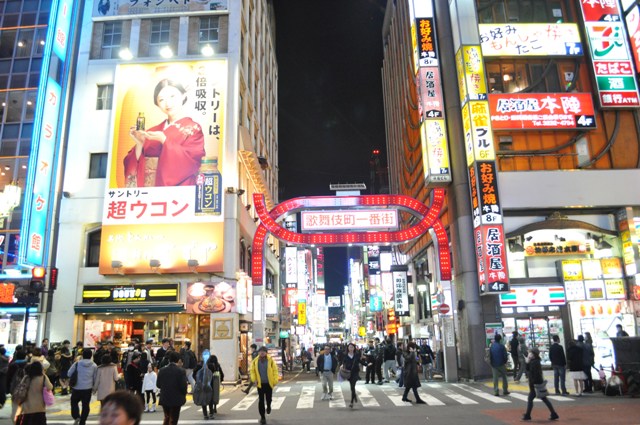
You think you understand the world. You think you know it. Then you travel to a place you’ve never been before and get completely blown away.
“You mean, this place actually exists?” Travel is the epitome of education. It’s experiential. It takes you out of the classroom, out of your comfortable bubble and forces you to experience another culture other than your own. There is no way you’ll travel abroad and NOT learn anything.
Tokyo is edgy and cosmopolitan. It’s hyper-active and always on the move. It’s quirky and cute; bizarre and cool; über modern and sky high; it’s fashionable and a fashion rebel (socks with sandals, it works!).
Tokyo is dense and densely populated — I mean, really dense. New York may have more taller skyscrapers. But Tokyo? Tokyo has way more skyscrapers in general; they may not be as tall, but there are definitely more. Some may find this suffocating, but for a city girl like me, feeling like a tiny speck against the tightly packed skyscrapers and neon lights is exactly what I loved.
Expect a clean city with lots of foot and cycle traffic; expect a city above ground and expect a whole other city underground. Expect to be in a major world city that is safe, but not boring or quiet.
Here’s what I experienced on my first trip to Tokyo:
1. CULTURAL TOKYO
You don’t have to be in remote, mountainous regions to experience authentic Japanese culture. If all you have time for is Tokyo, here’s what I experienced right in the city:
Shinto-Style Wedding Ceremony
Although western-style weddings have become the norm now in Japan, some brides and grooms still opt for a Shinto-style wedding ceremony. I had the honour of attending my friend’s wedding at Tokyo’s Meguro Gajoen, one of the oldest and most popular wedding halls in Tokyo – although ‘wedding hall’ doesn’t do it justice. Even if you don’t have a wedding to attend, come here anyways to witness the beautiful architecture and multitude of weddings happening all in one day. Meguro Gajoen is now a modern, multi-storied venue filled with many chapel halls, banquet rooms, hotel rooms and restaurants. Elements of art and architecture blend harmoniously together — high ceilings, glass windows and indoor and outdoor gardens give the space a very open concept feel. Although it’s an overwhelmingly large venue, the wedding I attended felt very intimate.
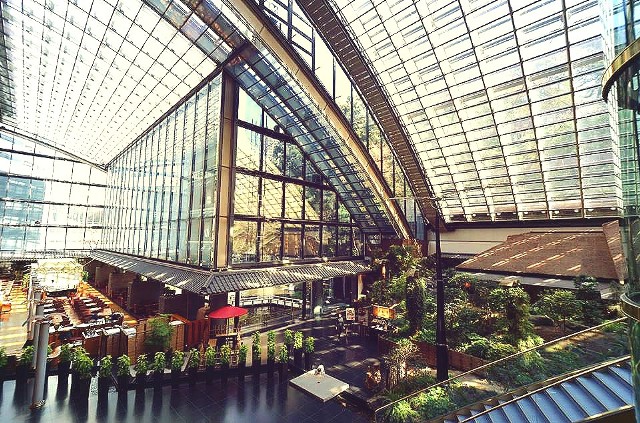
The Shinto wedding ceremony, led by the Shinkan — the Shinto priest–consists of several ceremonial stages: Sanshin (the procession); Shubatsu (the purification rites); Norito-sojo (prayer); San San Kudo (exchanging of sake); Seishi Sodoku (wedding vow); Tamagushi Hoten (presentation of the Sakaki branch, ritual presenting the safe end to the ceremony); Shinzoku-hai (guests drink sake). The ceremony took place in the morning in a shrine inside Meguro Gajoen. Guests were then treated to a formal lunch, followed by speeches. In the evening, I attended the nijikai, the after-party, and in some cases there’s even a sanjikai, the after-after party, usually at a karaoke bar.
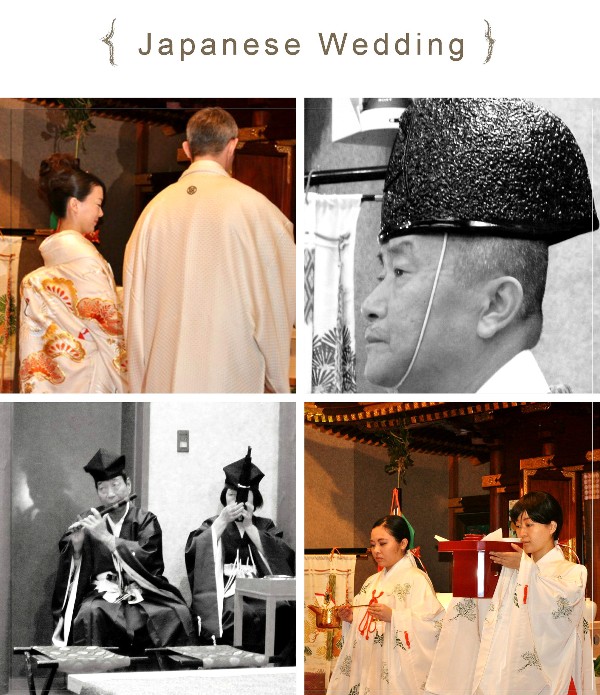
Attending the wedding ceremony of a local couple was a cultural experience I’ll never forget, especially when the groom is a close friend. But even if you don’t have a wedding to attend, you may be lucky enough to witness the Sanshin (wedding procession), at Shinto temples in and around Tokyo. You may not experience the whole ceremony, but seeing the bride and groom and their guests dressed in kimonos and traditional wear will give you that cultural experience if you only have time for Tokyo.
Tokyo Temples
Sensō-Ji Temple – Oldest Temple in Tokyo
The first temple on the Sensō-Ji grounds was founded in 645CE, making it the oldest temple in Tokyo. During WWII, the temple was bombed and later rebuilt and is a symbol of rebirth and peace for the Japanese people. Making our way to the Asakusa district of Tokyo, we visited this ancient Buddhist temple on a Saturday, an overwhelmingly busy day filled with thousands of worshippers and tourists visiting the shrine and surrounding grounds. The temple grounds also include rows upon rows of small shops and stalls that have been there for many years. If you do end up visiting on a weekend, be prepared for shoulder to shoulder large crowds leading up to the main shrine.
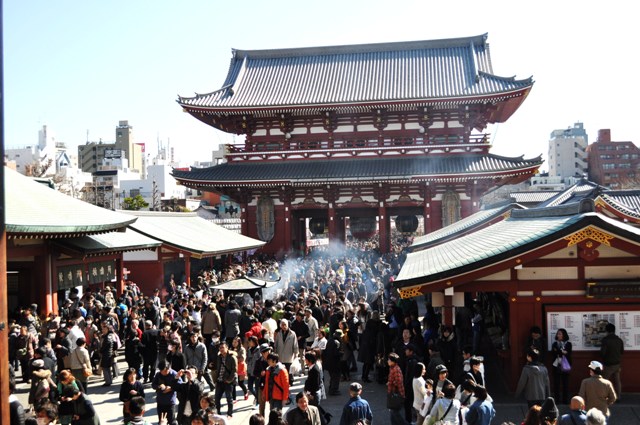
Don’t give up with the large crowds though. Walk around to the left of the shrine and you’ll see a peaceful, meditative Japanese garden to get your zen on.
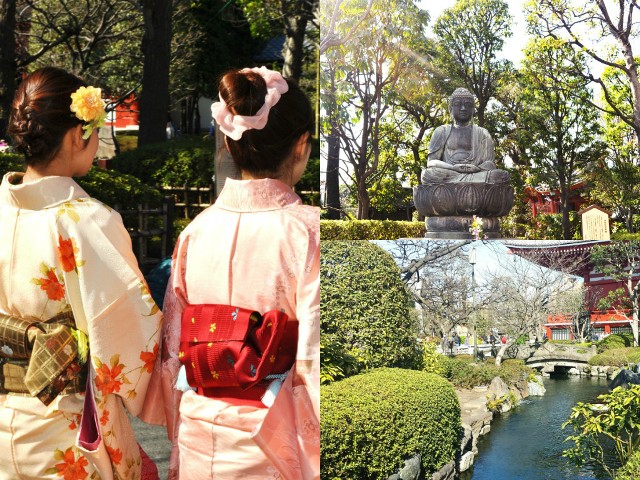
Meiji Shrine – Shinto Shrine Located within a Tranquil Forest
Nature plays a large part in Japanese culture, even in a large metropolis like Tokyo. Located beside the JR Yamanote Line’s busy Harajuku station, the Meiji shrine is dedicated to Emperor Meiji and his wife, Empress Shoken. Contemplative and peaceful, the shrine complex is located in an evergreen forest with 120,000 trees of 365 different species.
The Meiji shrine was a welcome respite after walking the packed lanes of Harajuku on a Sunday. Although busy, the long walk up to the Meiji Shrine still felt quiet and calm, not as overwhelming as the Senso-Ji shrine the day before.
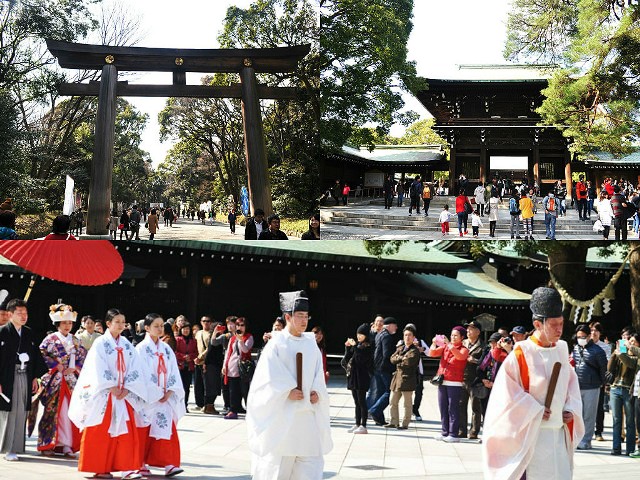
Popular with brides and grooms, after about a 10 minute walk on a gravel pathway lined by a forest, we came upon the main Meiji Shrine where an unexpected wedding procession was taking place.
2. TOKYO ON A BUDGET
“But isn’t Tokyo an expensive place to travel?”
Yes and no. This is one of the most common questions I get asked so let me explain. Accommodations and long-haul travel is expensive in Japan, but most food, city transportation, and cultural amenities are inexpensive.
There is no doubt Tokyo can be an expensive city. But just like any other world city such as New York or London, it’s all relative and depends on your tastes and spending habits. I found the biggest expense is getting there and staying there. Accommodations in popular districts such as Shinjuku and Shibuya are expensive, costing anywhere from $180 to over $200 per night and taking the Shinkansen (bullet train) out of the city from Tokyo to Kyoto was our largest transportation expense. Other than that, we found ourselves with plenty of budget options for good food and attractions without having to sacrifice our experience.
You don’t have to eat at the most expensive high-end sushi restaurants in Tokyo to experience good, delicious, fresh sushi. We ate at conveyor belt sushi restaurants, known as kaiten-sushi, and compared to the sushi restaurants in Vancouver, the main difference we found was the freshness of the fish. Even at the ‘fast food’ sushi places, you know the fish was just caught that day at Tsukiji Fish Market, the biggest wholesale fish and seafood market in the world.
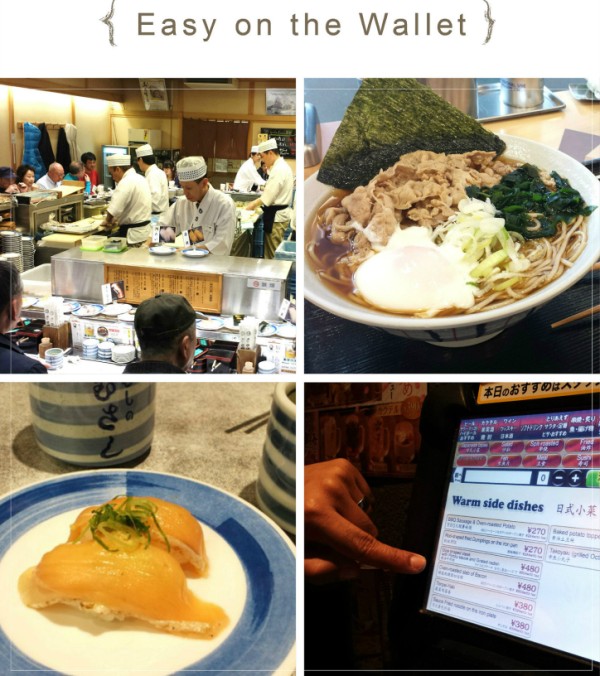
There are also plenty of Ramen noodle shops, izakayas, and delicious food served inside department stores. Unlike terrible food courts inside North American malls, the food options at Japanese department stores are really good and a popular place with the Japanese to pick up lunch or good quality desserts.
Other budget options include:
- Getting a Suica or Pasmo transit charge card (if you plan on travelling on trains, this comes in handy).
- Renting a Pocket Wi-Fi for ease of navigation and because most free Wi-fi hotpsots require registration in Japan (some in English, some not). Also, there aren’t as many free wi-fi hotspots because Japanese cell phone plans are relatively cheap and good for locals living there. For foreign travellers, this means you may not have as much easy access as in other places you may have travelled. We rented a Pocket Wi-Fi for 2 weeks (ordered online before we left on our trip) and had it delivered to our hotel in Tokyo. At the end, we used the return envelope and dropped off the pocket wi-fi in a mailbox at Osaka Airport. It came in really handy to find cheap eats quickly and made finding places less frustrating!
- If you love coffee, buy a ‘Breakfast Set’ (combo) in the morning to get your coffee included, otherwise coffee on its own can cost a lot (basic coffee for ~$5).
- Visiting the free observation deck at the Tokyo Metropolitan Building (more on this later)
- Visiting near-by temples (see above)
- Exploring different districts (each have their own character) such as Akihabara, Harajuku, Shinjuku, Shibuya and Ebisu.
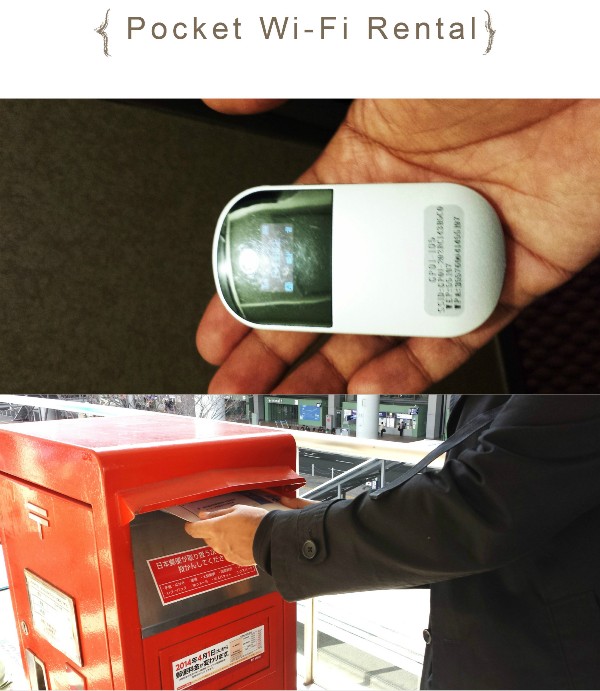
Don’t be turned away from Tokyo just because you’ve heard it’s really expensive. With pre-planning and using these tips, you can enjoy Japan without sacrificing your experience.
3. QUIRKY TOKYO
Sensory Overload: The Robot Restaurant
Walk through the neon-lit lanes of Kabuki-cho, Tokyo’s red light district, to find this crazy, colourful, glitzy cabaret show.
Anthony Bourdain covered it for CNN’s Parts Unknown. My friend in Tokyo nudged us towards it. “Don’t ask. Just go,” he wrote.
On our second night in Tokyo we made reservations and met up with a couple of friends to check it out. How could we resist?
What came next was an over-the-top explosive spectacle featuring massive robots, laser lights, dancing girls and non-sensical storylines. Half-naked girls battling evil robots? You got it. Pandas riding cows? Of course, why not? Robots getting down to Psy’s Gangnam Style? You betcha. Nothing is off limits in this hilarious, quirky, oh so very Japanese-y, entertaining show. Ridiculous? Yes. But worth it? Absolutely! There are no words to describe this show, but to experience it yourself. Come out confused and puzzled, yet amazed and entertained at the same time!
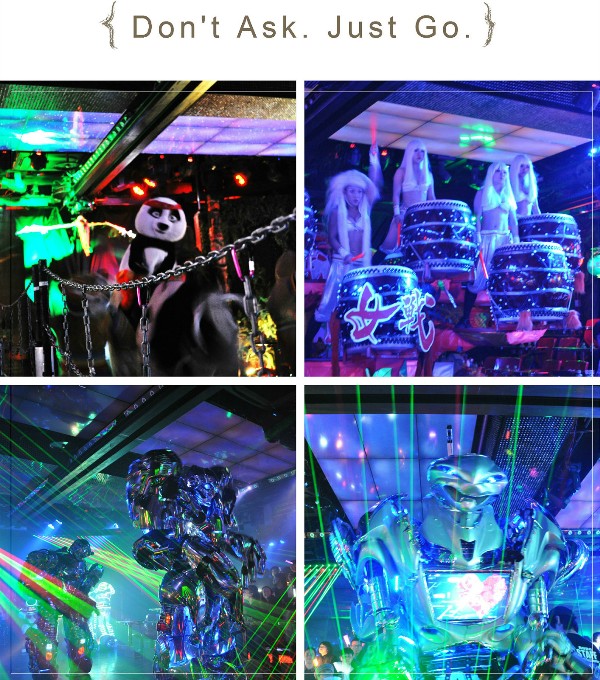
Cosplay in Harajuku
If you want a glimpse into Tokyo’s many subcultures, head to Harajuku– a gathering place for enthusiasts and aficionados of Japanese street fashion. Make sure to go on a Sunday afternoon – it’s when Tokyo’s teens flock to Harajuku station in their anime and manga wear to hang out and shop on Takeshita Dori, a 400 metre long street with various stores selling cosplay costumes, hip hop, gothic and punk wear. Cosplay (costume play) is a hobby where people dress up and embody their favourite manga, anime or video game character. From sweet Lolita and gothic Lolita-type outfits (Victorian-era clothing) to wearing fuzzy stuffed animals and platform high heels with socks, you’ll see a lot of quirky fashion on the streets of Harajuku. And if you want a picture – they don’t mind. Just ask.
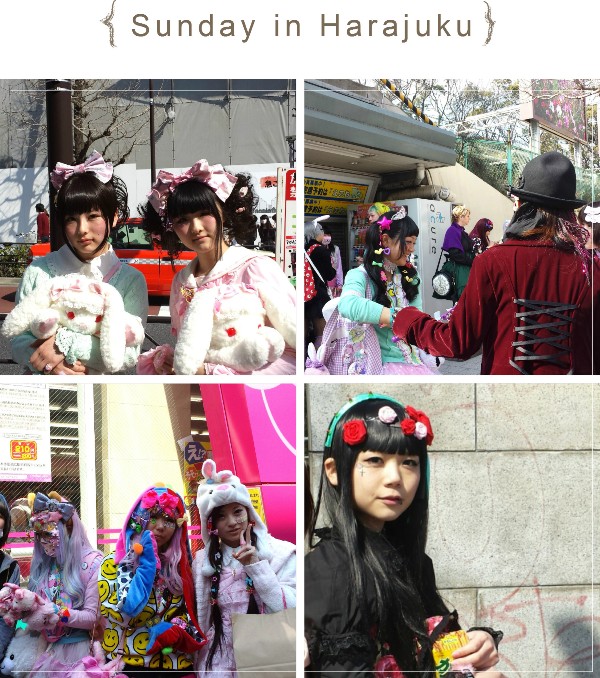
Akihabara “Electric Town”
If you’re into anime and manga, electronics or arcade games, this district is for you. Thousands of shops selling technological gadgets can be found here – computers, vacuums, dvds, video games, all at a reasonable price. Even if you’re not a fan of the anime/manga subculture (we aren’t), it’s still worth taking a look for a view into Tokyo’s subculture. From maid cafes to streets covered with sexualized and non-sexual manga and anime icons, Akihabara is at the heart of otaku (anime and video game fan) culture.
We wandered around Akihabara and along its many side streets, not really searching for anything, just taking it all in. We went to the Tokyo Anime Centre for a glimpse of Astro Boy, walked into arcades (you can even rent anime costumes while playing games – Sailor Moon anyone?!) and browsed electronics stores. Although we were hoping to find more futuristic-type electronics Japan is widely known for, it was still worth a look into the quirky side of Tokyo.
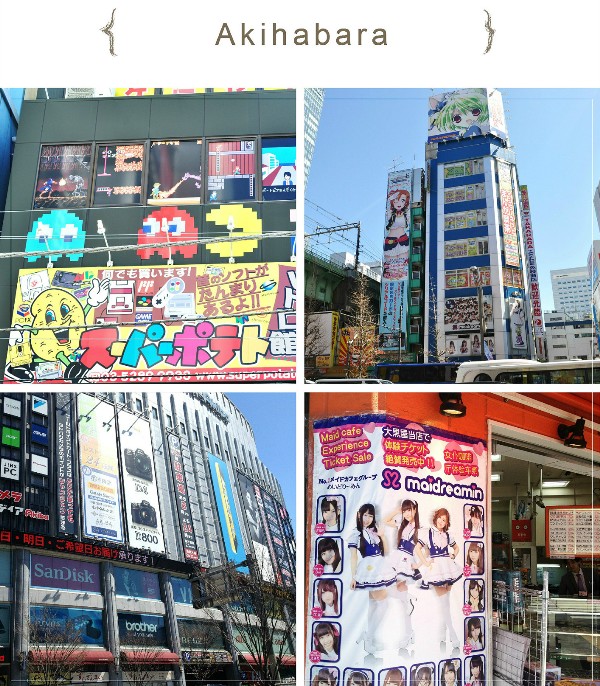
Cosplay in India
Cosplay and Otaku culture has become so popular over the years that it’s had a strong influence on creating a parallel subculture among youth in India:
4. FASHION EDGE
I’ve always known Tokyo to be a major high fashion hub (hello, Issey Miyake), but seeing Japanese street fashion in person puts Tokyo on a whole other level – and in my opinion – a few notches above New York or Paris. Street fashion in Tokyo, a mix of international and local styles, is just more noticeable than in other cities I’ve travelled. From classic, Parisian-style feminine wear (think lace, blush-coloured peacoats, lots of dresses, skirts and plenty of high heels) to edgy, punk styles in Harajuku and hipster wear in Tokyo’s Shimokitazawa district, young people know how to dress in this city.
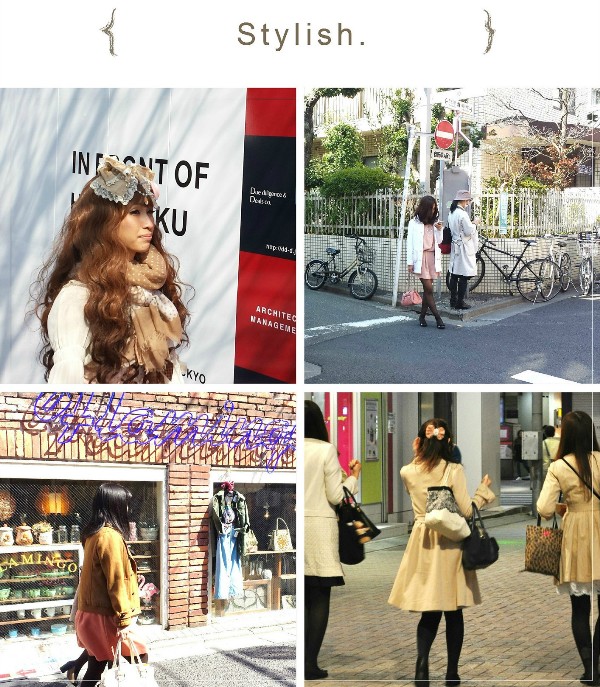
Tokyo is fashionable and a fashion revolutionary. Tokyo locals can take certain fashion ‘rules’ and turn them upside down for a new interpretation all their own.
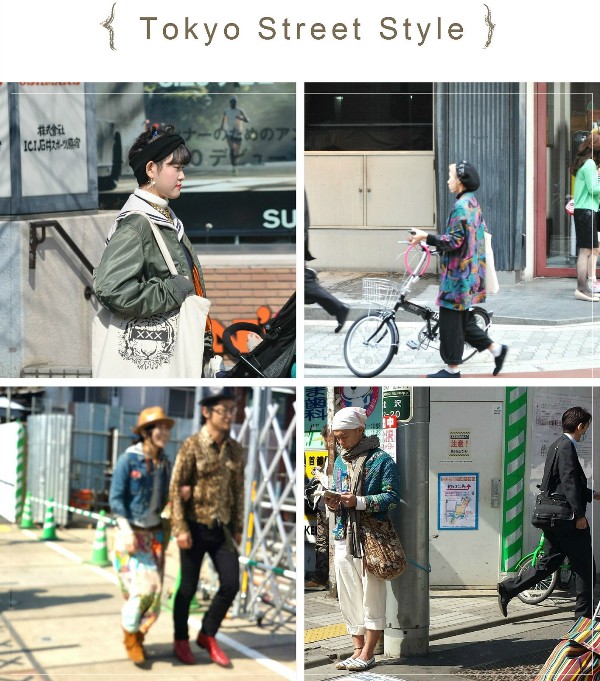
Massive platform sandals with socks? It works. School girl outfit with over-sized hipster glasses and a stuffed animal in your front jacket pocket? Why not. All while rocking out in a surgical mask.
Screw everything you know about fashion.
Surgical masks, worn to alleviate allergens, colds, flus and pollution in dense cities, are worn by many living in Tokyo – from suit-wearing salary men to glammed up fashionistas. I’m still surprised there is no Louis Vuitton labelled surgical mask yet. LV would make a killing.
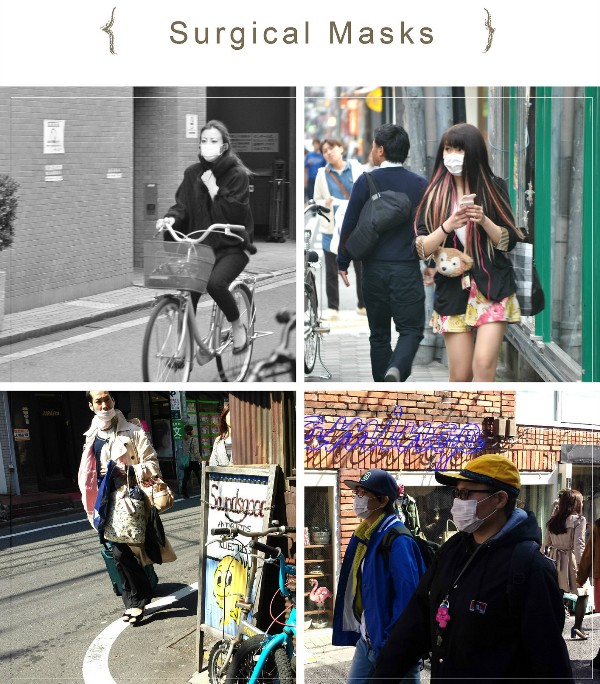
Throw away all that you know about fashion because Tokyo is a fashion rebel – and wears that title in style.
5. EXPERIENCE TOKYO FROM ABOVE, FROM BELOW, AND IN-BETWEEN
The first thing I noticed about Tokyo is its size and density. Looking out the shuttle window on our way to our hotel, seeing brightly lit buildings stretching far off into the distance in all directions, I already knew Tokyo was going to be enormous to explore. Now looking back, when taking a cab towards Manhattan a few months prior, New York City looked tiny compared to the size of Tokyo. To get a good understanding of Tokyo’s massive size, the best way to experience Tokyo is from different perspectives – from above, from below and in between.
From Above
Visit the Tokyo Metropolitan Government building (it’s free) for a full 360 degree panoramic view of Tokyo’s density from the top, including getting a glimpse of Mount Fuji. The observation decks are on floor 45 and 663 feet up in the air. For a varied experience, go once during the daytime for clarity (and good pics) and again at night to view the dazzling city lights from above.

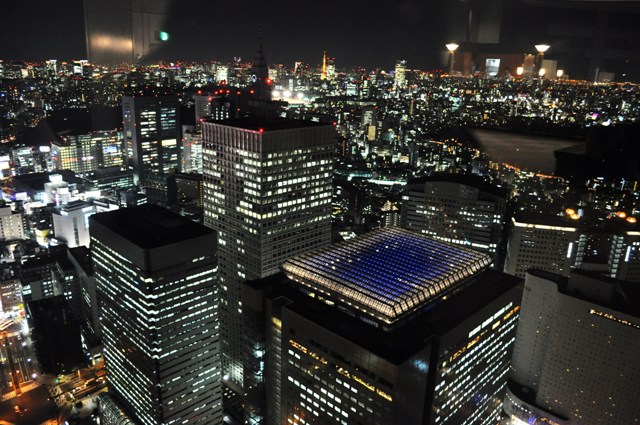
At street level, each skyscraper and storied building you see has a multitude of retail shops, restaurants and karaoke bars. In Tokyo, you can never just look at buildings at eye level – you have to look UP to find the place you’re looking for – and even then you may have to go inside the building to explore; addresses are confusing for visitors in Tokyo; the streets have no names and buildings are numbered in a random order. I should have read these helpful address instructions before I went.
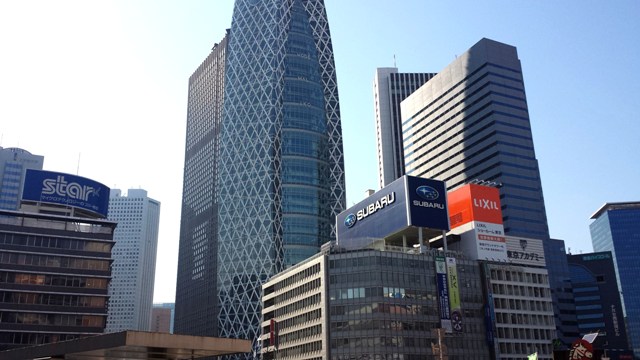
From Below
What no one seems to talk about in guide books and blogs is how much Tokyo is built underground. We had no idea until we experienced it ourselves going through Shinjuku Station, the world’s largest train station with 35 platforms, 2 million passengers, and a whole retail system built underground. With vast subway systems comes extensive underground shopping and restaurants and miles of pedestrian walkways and tunnels, making Tokyo’s underground another hotbed for human consumerism. We thought above ground was crazy. Go underground and there’s a whole new world of frenzied activity.
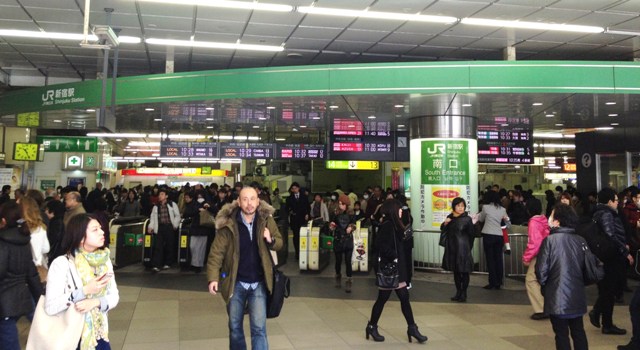
In Between
To experience Tokyo’s density at street level and to get a glimpse of Old Tokyo, make sure to get lost in between buildings, venturing off the main roads and into the alleys. You never know what you will discover. Golden Gai (known for its nightlife of nearly 200 tiny bars stuffed into 6 narrow alleys) and Omoide Yokocho (known for rows of Yakitori stalls and micro-sized eateries) in Shinjuku were two of my favourite areas in Tokyo to explore. Stretch your arms out and you can almost touch wall to wall.
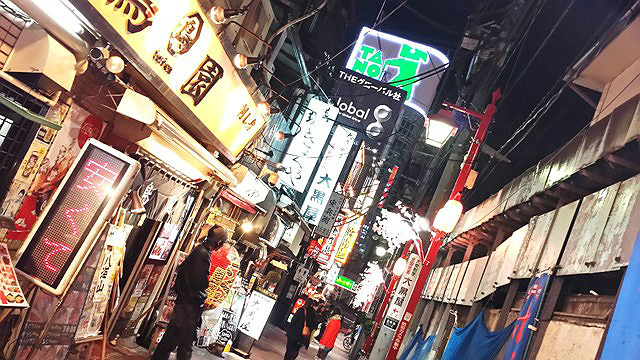
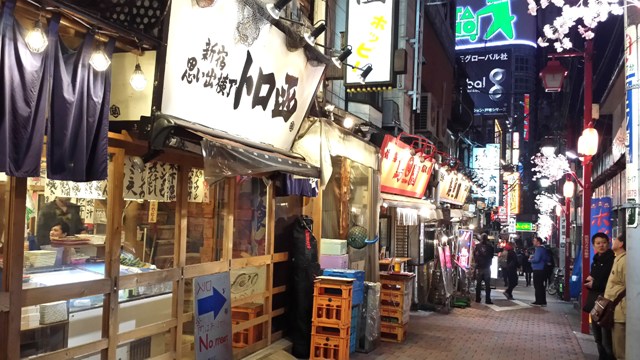
The best way to explore Tokyo – from above, from below, and in-between.
6. JAPANESE TOILETS REALLY ARE THAT AWESOME
Japanese style toilets are nothing new. The world has known about them for a long time. But experiencing one on your first trip to Tokyo? You won’t want to go back to anything else. In Japan – your tush is also on vacation.
European bidets? They don’t make sense to me anymore. Why waste space?
Built-in bidets, bum warmers, deodorizers AND a button to play music while you do your business – now that’s a Japanese toilet, an all-in-one high-tech solution. At first, encountering a Japanese toilet can be terrifying – so many buttons, unknown symbols, volume controls, pressure controls and water sprayers – but once you’ve sat on a Japanese porcelain throne, you’ll want to say good bye to those archaic, boring flush toilets.
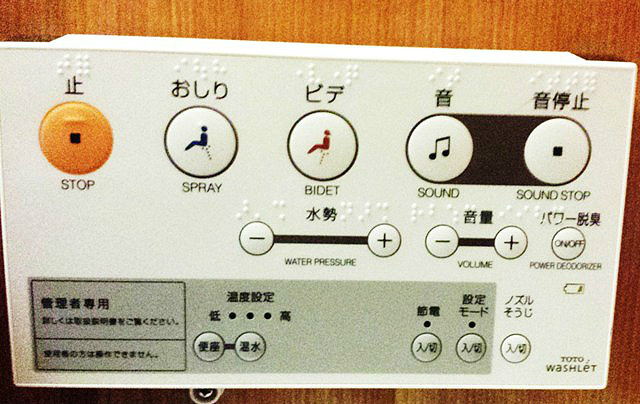
Our tushes will thank us.
7. VIBRANT CYCLING CULTURE
I had no idea cycling is so popular with everyday urbanites in Japan. I’m not talking about just hard-core ‘green’ cyclists or low-income workers. The cycling culture seems to even rival that of Amsterdam in my mind. According to an article in Japan Times this year, 14% of all journeys in Tokyo are made on bicycle, compared to 2% in London and 1% in New York and there’s nearly twice as many bicycles as cars on the road in Tokyo.Well, sidewalks more so than roads, since it’s still legal to ride on sidewalks in Tokyo.
From mothers to grandparents, students to fashionistas, the salaryman to the fisherman– there’s no proto-typical cyclist in Tokyo; it’s a popular form of transportation for many.
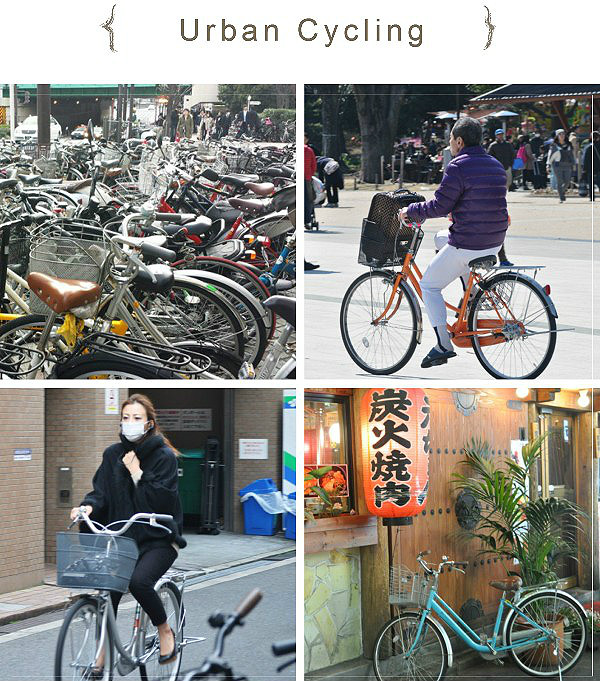
Have time to spare on your trip? Rent a bike for a day and follow the locals!
8. TRANSPORTATION: WHAT TO EXPECT ON TOKYO TRAINS
Tokyo is covered by a dense network of trains, subways and buses, operated by a dozen different companies. We mostly took the train and subway lines, which can be a maze to figure out and can get confusing. Shinjuku Station in Tokyo is the largest in the world with 35 platforms and millions of commuters travelling everyday. Forget the guidebook and rent a pocket wifi for the duration of your trip. The good thing is Google Maps has Tokyo figured out inside out and that helped ALOT.
If you do get lost though, there is lots of help available at the stations (even online English translators) and there’s no need to get anxiety over the many, many commuters travelling everyday. The Japanese are known for their respectful etiquette – it forms the back bone of their culture and it bleeds into all aspects of life, including how they interact with their fellow commuters.
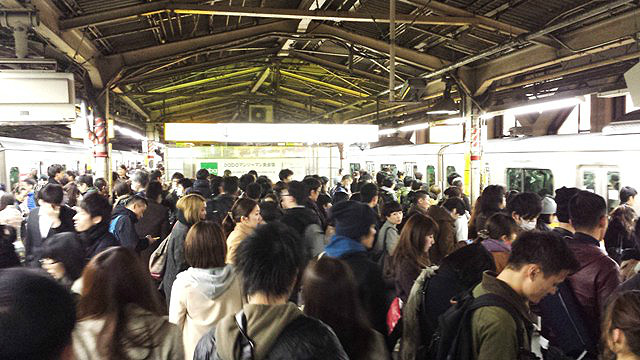
Trains are on time and orderly – people wait until others get off and it’s a given people will give up their seats for the elderly or pregnant women.
Inside the train, people can use their cell phones to listen to music or scroll the internet, but you aren’t allowed to talk on the phone out of respect for others on the train. After experiencing train travel in Tokyo, this type of respect on trains should be followed in every country.
Travel Japan: Tokyo is an amazing place to visit. Have you experienced similar things on your first trip to Tokyo? Did anything surprise you? Write your thoughts in the comment section below!
